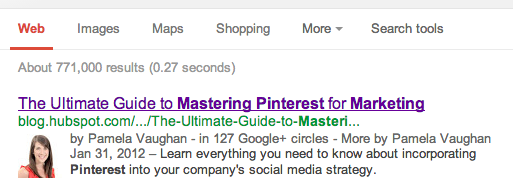When experts talk about Search Engine Optimization they often talk about zillions of technical tips and tricks, but don't let that fool you into an endless checklist of code tweaks. What you should really focus on are the humans using the search engine.
SEO is a critical part of web analytics. We'll introduce you to two tools that will help you quickly fix any egregious technical SEO errors, and then introduce two types of content that'll boost your search traffic (and a tool to help!)
Healthy sites should have 30-50% of their traffic coming from organic search. And search traffic tends to be very high quality because the user has already shown interest in your product's domain. You'd be crazy not to take a few minutes to optimize search—it's the tippy top of your conversion funnel, where users find out about you for the first time.
4 SEO Quick Wins to Implement Today
Here are 4 simple things you can do to optimize your content for performance in search engines.
1. Start with easy technical fixes
The easiest 1-hour win is to simply check that search engines can find and understand your website. It's arguably the most important piece of the SEO puzzle: If your site can't be found or understood by the engines looking for them, there's no way you'll ever show up in the SERPs (Search Engine Results Page).
There are a bunch of common mistakes that only take a couple minutes to fix that can drastically help with this. These fixes will pay off in better search rankings forever.
Your first step: Check to see how many and which pages of your website have been indexed by Google using "site:yourdomain.com", an advanced search operator. Head to Google and type "site:yourdomain.com" into the search bar. This will return results Google has in its index for the site specified.
This will give you a good idea of how much work needs to be done.
When we were just starting Segment, we used SEOmoz to identify some fixes that needed to be made. At that time, the list included quick fixes like:
Images should have alt tags so that search engines can understand them
Titles and meta description tags should be descriptive and unique
example.com/robots.txt should exist, and tell search engines what's ok to index
example.com/sitemap.xml should point search engines to interesting parts of your site
So, as a part of the process to up our own SEO game, we updated our titles and meta descriptions (which only takes a couple of minutes). Then we nudged Google Webmaster Tools to re-index the changed pages. Instead of searchers seeing an ugly, out of date search result for Segment, we had our latest and greatest positioning ready to be viewed:

The best way to find errors like these on your own site is to use an automated tool. We highly recommend SEOmoz and HubSpot's free Marketing Grader, and you can verify that your fixes are working by registering for Google Webmaster Tools. Be sure to enable email notifications so that you get alerts on any Googlebot crawler errors.
These technical tips and tricks are easy wins that everyone should take advantage of. There's no reason a silly technical error should kill off your search engine traffic or boost your conversion rate because it takes practically no time to fix.
With all the small technical errors fixed, it's time to focus on the hard part of SEO.
2. Optimize for humans using the search engine
The key question is "When people want my product, what keywords do they search for?" Finding the answer to this question requires keyword research. For example, you might operate a Bitcoin exchange and target a phrase like "bitcoin exchange," but instead people actually search for "convert bitcoins to USD". A key part of improving your search rankings is to write copy and content that addresses searchers in their frame of mind.
In the bigger picture, 20% of searches are for short, 1 or 2-word keywords (the "fat head")… but 70% of searches are for a massive variety of keywords that have 3 or more words in them, like "convert bitcoins to USD". This is called the "long tail".

In order to rank highly for long tail keywords, you need to write copy with keywords that people actually search for (and make sure the keywords are in the title tag and headers as well). Too often, people interpret this narrowly and create a spammy mess. Check out the footer of Kayak.com for an example:

That huge mess of " flights", and the amusingly repetitive "cheap flights" copy is targeting the keywords that people really use when they're looking for flights.
3. Work your keywords into useful content
Instead of cloning the Kayak footer, keep the user experience in mind and write content using the keywords that are useful to your users. One strategy for doing this is called "bunting", like in baseball. A "bunt" is a blog article or landing page written to match a specific long-tail keyword.
For example, you could write a blog article called "Convert Bitcoin to USD" and explain how that works, showcasing your Bitcoin exchange. The goal of the content is to write something interesting to the people searching for it, and repeat the keyword enough, in context, that search engines decide it's a good match.
Then you repeat this process for many keywords ("Convert Bitcoin to Yen", "What is the genesis block chain?", …), building up a library of long-tail keywords that each drive a trickle of high-quality search traffic.
Here's a real-world example of "bunting" from a site that sells, of all things, organic insecticides.

Case Study: Growers Trust
The main product at GrowersTrust.com is an organic spider mite insecticide. They targeted one long-tail keyword and wrote a simple blog article that generated profitable revenue in the first 4 days:
Someone looking for "Spider Mites" might just want to see a picture of the bug. Perhaps they are researching pests in general for a school project. Who knows what they want! While it certainly is nice to have any traffic to your website, a visitor who is more qualified and primed to buy your product is much more desirable…
We had a piece of content written that focused on the keyword, "Spider Mites Treatment". We added it to the blog on our E-Commerce store and added the URL to Google via our Webmaster Tools console (this speeds up the process of getting the new content found by Google). Within 2 hours, the content was indexed by Google and was able to be found for many long tail keywords.
The blog post got 30 unique visitors and 1 sale. If that was in 4 days, imagine how much traffic you could see from that one post in 30 days. That would be 225 visitors and nearly 8 sales! Since we only paid $19 dollars for the content and sold one bottle of organic pesticide for twice that amount, we are already in the black on our ROI.
Here's the blog post.
You're not changing the world when you bunt. You'll need a lot of content pieces to generate real business. But if you consistently target new long-tail keywords and build up a long list of them, it's a gift that keeps on giving.
There is a second strategy if you prefer being more dramatic! Instead of just writing articles that match long-tail keywords, you can go after keywords in the fat head. Since there are so many sites competing for these fat head keywords, you'll need to be clever about producing high-quality content.
Search engines sort their results based on people linking to and sharing your site. So in the fat head, you need to get people to distribute links by sharing your content all over the place.
4. Create provocative, highly shareable content
You need a piece of content so hilarious or assumption-shattering that people can't stop sharing it with their friends and colleagues; this is how you stack up backlinks to your site.
Like hitting a home run, this is hard. You won't hit home runs every time. Just practice your writing, get feedback from better writers, and stay on top of your industry. Part of what makes great content explosively popular is timing. Here's an example from HubSpot.

Case Study: Hubspot
HubSpot is an inbound marketing and analytics company. They're incredibly successful at generating content that brings in new leads. Here's one of their own success stories:
When Pinterest was gaining traction, we were one of the first blogs to publish a guide to using Pinterest for marketing. We then referenced that article in our pitches to the media, who were already looking for sources as they were covering the rise of Pinterest. It led to some awesome coverage for us, including an article in the Boston Globe.
Not only did they get press mentions from it, but since the article has been around since the early days of interest in Pinterest, much of the newer content about marketing on Pinterest has linked back to the original post from HubSpot (just like that!). As a result, the article has great rankings in Google Search results:

The big takeaway from this case is, in HubSpot's own words: "Is there a popular topic in your industry that few have written about (or written about well) where you see an opportunity? Jump on it!"
When you sit down to optimize search results for your own site, be sure to set up SEOmoz, Google Webmaster Tools and the HubSpot Marketing Grader. These tools will help you fix any major technical issues. Once you've resolved them, stay focused on creating great content.
Look for groups of long-tail keywords that are highly relevant to your business, and try out bunting. When you have an idea for brilliant and well-timed content, go for a home run.
Your homework for this week is to take action on your blog. Bunt once and swing for a home run too. What will your audience find useful?
For more SEO info, check out our guide to programmatic SEO vs. editorial SEO.
PS. If you run into technical SEO issues and need to troubleshoot more deeply, check out Google's Youtube Channel and Google Webmaster Help for super-detailed answers.